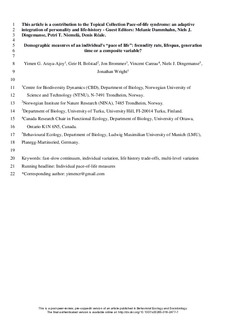| dc.contributor.author | Araya-Ajoy, Yimen | |
| dc.contributor.author | Bolstad, Geir Hysing | |
| dc.contributor.author | Brommer, Jon | |
| dc.contributor.author | Careau, Vincent | |
| dc.contributor.author | Dingemanse, Niels J. | |
| dc.contributor.author | Wright, Jonathan | |
| dc.date.accessioned | 2018-11-19T10:09:58Z | |
| dc.date.available | 2018-11-19T10:09:58Z | |
| dc.date.created | 2018-07-06T12:14:10Z | |
| dc.date.issued | 2018 | |
| dc.identifier.citation | Behavioral Ecology and Sociobiology. 2018, 72:75 (5), 1-14. | nb_NO |
| dc.identifier.issn | 0340-5443 | |
| dc.identifier.uri | http://hdl.handle.net/11250/2573394 | |
| dc.description.abstract | Comparative analyses have demonstrated the existence of a ^pace-of-life^ (POL) continuum of life-history strategies, from fastreproducing short-lived species to slow-reproducing long-lived species. This idea has been extended to the concept of a ^pace-oflife syndrome^ (POLS), an axis of phenotypic covariation among individuals within species, concerning morphological, physiological, behavioral and life-history traits. Several life-history metrics can be used to place species in the fast-slow continuum; here, we asked whether individual variation in POL can also be studied using similar life-history measures. We therefore translated measures commonly used in demographic studies into individual-level estimates.We studied fecundity rate, generation time, lifespan, age at first reproduction, fecundity at first reproduction, and principal component scores integrating these different metrics. Using simulations, we show how demographic stochasticity and individual variation in resources affect the ability to predict an individual’s POL using these individual-level parameters.We found that their accuracy depends on how environmental stochasticity varies with the species’ position on the fast-slow continuumand with the amount of (co)variation in life-history traits caused by individual differences in resources. These results highlight the importance of studying the sources of life-history covariation to determine whether POL explains the covariation between morphological, physiological, and behavioral traits within species. Our simulations also show that quantifying not only among-individual but also among-population patterns of lifehistory covariation helps in interpreting demographic estimates in the study of POLSs within species. | nb_NO |
| dc.language.iso | eng | nb_NO |
| dc.title | Demographic measures of an individual's "pace of life": fecundity rate, lifespan, generation time, or a composite variable? | nb_NO |
| dc.title.alternative | Demographic measures of an individual's "pace of life": fecundity rate, lifespan, generation time, or a composite variable? | nb_NO |
| dc.type | Journal article | nb_NO |
| dc.type | Peer reviewed | nb_NO |
| dc.description.version | acceptedVersion | nb_NO |
| dc.rights.holder | © Springer-Verlag GmbH Germany, part of Springer Nature 2018 | nb_NO |
| dc.subject.nsi | VDP::Zoologiske og botaniske fag: 480 | nb_NO |
| dc.subject.nsi | VDP::Zoology and botany: 480 | nb_NO |
| dc.source.pagenumber | 1-14 | nb_NO |
| dc.source.volume | 72:75 | nb_NO |
| dc.source.journal | Behavioral Ecology and Sociobiology | nb_NO |
| dc.source.issue | 5 | nb_NO |
| dc.identifier.doi | 10.1007/s00265-018-2477-7 | |
| dc.identifier.cristin | 1596100 | |
| dc.relation.project | Andre: European Research Council (ERC-2010-AdG 268,562) | nb_NO |
| dc.relation.project | Norges forskningsråd: 223257 | nb_NO |
| cristin.unitcode | 7511,3,0,0 | |
| cristin.unitname | Avdeling for akvatisk økologi | |
| cristin.ispublished | true | |
| cristin.fulltext | postprint | |
| cristin.qualitycode | 1 | |
